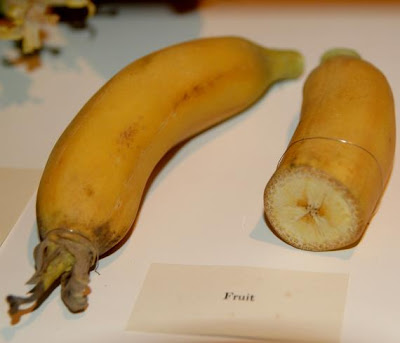 |
| Image courtesy of Muffet/Wikipedia. |
The Germans have a word for it - "königliche Gemüse" - which means "royal vegetable". It is rumored that there is a 3,000 year old Egyptian frieze with asparagus, but hours of searching for an image have been unfruitful. The first written mention of it was circa 150 BCE where it was addressed with much reverence by Marcus Porcius Cato. In the 2nd century CE, the physician, surgeon, and philosopher Galen described it as cleansing and healing.
 |
| An asparagus lover's dream. Image courtesy of RyanFreisling/Wikipedia. |
The oldest surviving book of recipes, Apicius's 3rd century
CE De re Coquinaria, Book III, has a recipes for cooking asparagus. (Click
here for a look at
patina de asparagis frigida in English.) There's been a lot of conjecture about Apicius, but there is agreement that no one named Apicius wrote this book. Apparently in the 90s BCE, a Roman named Apicius was a lover of luxury and lavish entertainment, and outdid himself with his feasts. His name became synonymous with gourmand, and was taken by Marcus Gavius Apicius of the 1st century CE who had similar tastes.
The name became immortalized in Roman literature, and thus this first cookbook was attributed to Apius, but what that meant to contemporaries was gourmet, foodie, or even glutton, not a specific person. It is sometimes attributed to Caelius Apicius, an invented name from the words "API CAE" on the heading of one of the manuscripts. Recipes for asparagus, then a food consumed by the wealthy, were included.
 |
| Frontispiece of the above manuscript, courtesy Kansas State U. |
In early times it was both a delicious and much sought vegetable and a medicinal food, due to its diuretic properties. Asparagus has always been rather infamous for its "filthy and disagreeable Smell in the Urine", as French scholar Louis Lemery wrote in 1702. The odor is caused by methylmercaptan, which is excreted through urine. But not everyone can smell it. The conclusion of a 2010 study published in the Oxford Journal
Chemical Senses found that while most people secrete the compound, only 22% have the genes to smell it.
 |
Three kinds of asparagus at a Boston market. White in the rear, green in the
center, and "bath asparagus" in front. Image courtesy of Wikipedia. |
There's not much record of it in the Middle Ages, and it didn't show up in print until circa 1100 CE as an herb. In 1565 it appeared in a catalog of plants in a German prince's garden where it was referred to as "delightful fare for lovers of food". In the 17th century asparagus raises its spear again. Once the food of the nobility, it became available to the middle class.
 |
German botanical illustration from 1885.
Image courtesy of Wikipedia. |
Known as "spargel" in German, asparagus season or "Spargelzeit" is a big event. Some towns, including Abensberg, Schwetzingen, and Schrobenhausen, sponsor competitions, seminars, and tours. Every restaurant will have several asparagus dishes on their menus, and people eat it as much as they can afford.
Schrobenhausen, in Bavaria, is the site of a year-round asparagus museum. Founded in 1985 by a town councilman, Dr. Klaus Englert, it occupies three floors of a 15th century tower. The ground floor is devoted to traditions of asparagus farming and the history of the European asparagus market.
 |
| Ground floor exhibit. Image courtesy Schrobenhausen.de. |
The first floor has displays of dishes and recipes, and the second floor includes paintings from Dutch and Flemish Schools. The various exhibits include advertising, agriculture, art, conservation, curiosities, decorations, gastronomy, history, literature, medical and pharmaceutical science, and table decorations.
 |
Spargelzange, or asparagus tongs, by Peter Carl Faberge, 1890, are part of
the museum's collection, Image courtesy Schrobenhausen.de. |
Asparagus is a spring vegetable and a flowering perennial. It is native to most of Europe, northern Africa, and western Asia. And I will share with you one of my quick and tasty recipes for asparagus:
 |
Also in the museum is this painting Springtime by Sonja McBesch, 1984.
Image courtesy of Schrobenhausen.de. |
Asparagus Ravioli Pie
1 package frozen cheese ravioli (or homemade if you wish)
3 eggs
1 can condensed cream of asparagus (or mushroom, if you prefer) soup
1 small bundle fresh asparagus, chopped into small pieces
sliced or shredded mozzarella, to cover
Set oven to 350º. Boil 1/2 package of the ravioli. In the meantime grease a 9" pie pan. Beat the three eggs, then slowly add the soup (do not add liquid to it) until it's blended and creamy. Toss in the chopped asparagus.
When the ravioli are al dente, drain them and let cool enough that you can handle them easily. Line bottom and sides of pie plate with them. Pour egg/soup/asparagus mixture over the ravioli. Top with mozzarella. Bake for 45".
You can refrigerate it once it has been put together. I always make two at once, but the second one never lasts 24 hours. You can also add other vegetables to it. I often add mushrooms, sometimes zucchini or yellow squash. I also have made a bigger, two-layer pie, splitting the egg/soup mixture to cover both layers (and adding mozzarella to both layers).
Bon appetit!
***************

























































